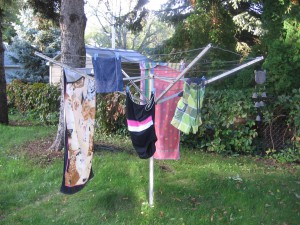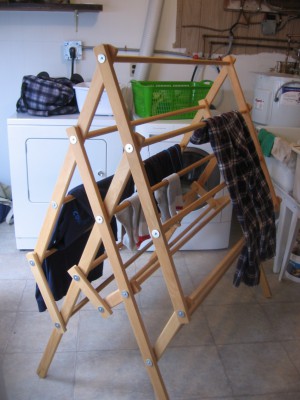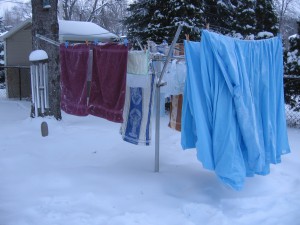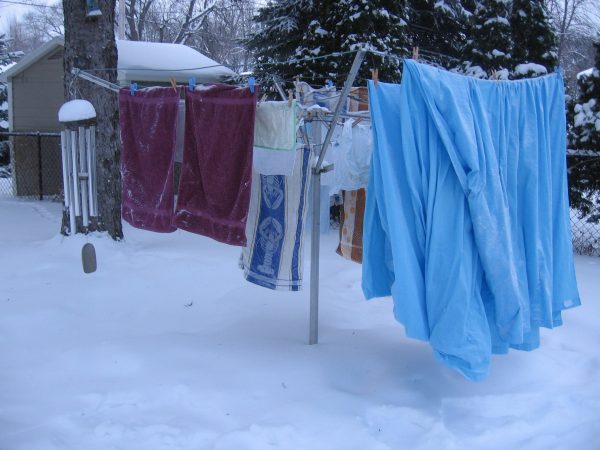*30th Anniversary guest blog post*
Everything I know about reducing my environmental footprint I learned from my mother, my grandmother, and Green Action Centre. It was 10 years ago this fall that my mother suggested to me that I hang my clothes outside all year around (yes even in -40 C’/F’). She gave me this advice in the fall so with winter on its way, I took it as a challenge.
Where do I start?

A rotary clothesline firmly anchored into the ground.
Well you start with a clothesline, some clothespins and a basket of freshly washed laundry. Simple? Well, not exactly.
First you choose a clothesline that best meets your needs. There are three basic types:
- The traditional line of a cord strung between two posts or trees; this is ideal if you have lots of room and posts are anchored securely in the ground. It allows for maximum air circulation and sun exposure.
- A rotary line which has a center post with spokes radiating out from the center, and between the spokes are rows of lines to hang clothing over. The rotary line is good choice for a smaller backyard and also requires adequate anchoring.
- A ‘clothes horse’, which is a fold-up rack with several rods to hang clothes over. The fold-up style can be used almost anywhere, inside or even on a small balcony. They come in a variety of sizes and are available in specialty hardware stores.

A clothes-horse is adaptable to use in many spaces.
Next is to select your style of clothespin; Plastic or wood? Spring or one-piece? Plastic works well in summer because they do not discolour from the rain like wooden ones. However, they do tend to break in the cold. The one-piece pins look nice, but do not hold the clothes as well as the spring type.
What are the benefits?
The most obvious benefit is environmental; using the sun and the wind to dry your clothes reduces energy consumption in your home. The only clean energy is the energy you don’t use. Drying clothes outside also saves you money. A clothesline-loving friend of mine estimated that she saved up to $50 a month on her energy bill, for a family of three. And did you know that the sun has the power to reduce the overall amount of bacteria that may lurk in the dampness of your towels? Perhaps the best benefit of all is the natural outdoor fresh scent, eliminating the need for that synthetic aroma boasted by the detergent companies.
What else should I consider?
There are a few things to be aware of. One challenge I have heard is that birds sometimes perch in the trees above the clothesline, resulting in bird droppings on the clothes. If you find that this is happening, it is best to move your clothesline to another spot. It has been my experience with birds that they have a blatant disregard for other people’s things. You don’t have to worry about them sitting directly on your clothes however as they don’t like the flapping movement of the clothes, no pun intended.
Squirrels are another issue, especially in the fall. Last fall I had my clothesline vandalized twice by squirrels. I don’t know if they were angry with me for sweeping up some of their nuts or if they were looking for material to line their nest with for the winter. In the fall I try to keep drying time to a minimum.

Rotary clothesline used in winter. It takes a few days for clothes to dry in the cold winter, but they will dry.
While in summer it usually only takes clothes a few hours to dry, in winter it takes several days. Be sure you have enough clean clothes to last you through the extended drying period. Going to work wearing frozen underwear from the line can really make for a bad start to your day.
The disinfecting ultra violet from the sun can whiten your whites, but it can also fade your coloured clothes. To avoid this, if you have a rotary line, you can hang the coloured clothes on the inner lines and the whites on the outside or hang the coloured clothes on the shadier side of the clothesline. I turn my coloured clothing inside out before hanging and leave them outside for the minimum amount of time.
With a bit of planning, any and all of these challenges can easily be overcome.
Ten years later, I am still using my clothesline and would not even consider using a dryer. Does this mean that I am turning into my mother?
If you have any comments, ideas, antidotes, or photos on clothesline drying, we’d love to hear from you.
—————————————————————————————————
Linda lives with her husband in Winnipeg. She is a teacher, a nurse, a farmer, and a Master Composter.





Recent Comments